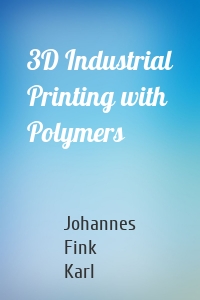Johannes Fink Karl
7 кн.
A Concise Introduction to Additives...
Describes twenty-one of the most important and commonly used additives A Concise Introduction to Additives for Thermoplastic Polymers focuses on additives for thermoplastic polymers and describes 21 of the most important and commonly used additives from Plasticizers and Fillers to Optical Brighteners and Anti-Microbial additives. It also includes chapters on safety and hazards, and prediction of service time models. While there are many exhaustive and complex books dealing with additives for...
| Автор | Johannes Fink Karl |
Polymeric Sensors and Actuators
This book covers in-depth the various polymers that are used for sensors and actuators from the vantage point of organic chemistry. Since many chemists may not be familiar with the physics and operational specifics of sensors, the book has a general chapter dealing with the overall physics and basic principles of sensors. Also included are methods of fabrication, as well as information on smart textiles, actuators, and the processing of data. The range of sensors covered include humidity,...
| Автор | Johannes Fink Karl |
Handbook of Engineering and Special...
This book focuses on common types of polymers belonging to the class of water soluble polymers. It covers a wide range of applications: food, cosmetic, medical, lithography and ink jet printing, agricultural, wastewater cleaning, and oilfield. The text is arranged according to the chemical constitution of polymers and reviews the developments that have taken place in the last decade. Each chapter follows the same template. A brief introduction to the polymer type is given and previous monographs...
| Автор | Johannes Fink Karl |
Handbook of Engineering and Special...
Utilizes an encyclopedic approach to cover the developments in polyolefins and styrenics during the last decade This book focuses on common types of polymers belonging to the class of polyolefins and styrenics. The text is arranged according to the chemical constitution of polymers and reviews the developments that have taken place in the last decade. A brief introduction to the polymer type is given and previous monographs and reviews dealing with the topic are listed for quick reference. The...
| Автор | Johannes Fink Karl |
Fuel Cells, Solar Panels, and Stora...
This book focuses on the materials used for fuel cells, solar panels, and storage devices, such as rechargeable batteries. Fuel cell devices, such as direct methanol fuel cells, direct ethanol fuel cells, direct urea fuel cells, as well as biological fuel cells and the electrolytes, membranes, and catalysts used there are detailed. Separate chapters are devoted to polymer electrode materials and membranes. With regard to solar cells, the types of solar cells are detailed, such as...
| Автор | Johannes Fink Karl |
3D Industrial Printing with Polymer...
3D industrial printing has become mainstream in manufacturing. This unique book is the first to focus on polymers as the printing material. The scientific literature with respect to 3D printing is collated in this monograph. The book opens with a chapter on foundational issues such and presents a broad overview of 3D printing procedures and the materials used therein. In particular, the methods of 3d printing are discussed and the polymers and composites used for 3d printing are detailed. The...
| Автор | Johannes Fink Karl |








